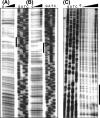MisR/MisS two-component regulon in Neisseria meningitidis
- PMID: 18056476
- PMCID: PMC2223465
- DOI: 10.1128/IAI.01007-07
MisR/MisS two-component regulon in Neisseria meningitidis
Abstract
Two-component regulatory systems are involved in processes important for bacterial pathogenesis. Inactivation of the misR/misS system in Neisseria meningitidis results in the loss of phosphorylation of the lipooligosaccharide inner core and causes attenuation in a mouse model of meningococcal infection. One hundred seventeen (78 up-regulated and 39 down-regulated) potential regulatory targets of the MisR/MisS (MisR/S) system were identified by transcriptional profiling of the NMBmisR mutant and the parental wild-type meningococcal strain NMB. The regulatory effect was further confirmed in a subset of target genes by quantitative real-time PCR and beta-galactosidase transcriptional fusion reporter assays. The MisR regulon includes genes encoding proteins necessary for protein folding in the bacterial cytoplasm and periplasm, transcriptional regulation, metabolism, iron assimilation, and type I protein transport. Mutation in the MisR/S system caused increased sensitivity to oxidative stress and also resulted in decreased susceptibility to complement-mediated killing by normal human serum. To identify the direct targets of MisR regulation, electrophoretic mobility shift assays were carried out using purified MisR-His(6) protein. Among 22 genes examined, misR directly interacted with 14 promoter regions. Six promoters were further investigated by DNase I protection assays, and a MisR-binding consensus sequence was proposed. Thus, the direct regulatory targets of MisR and the minimal regulon of the meningococcal MisR/S two-component signal transduction system were characterized. These data indicate that the MisR/S system influences a wide range of biological functions in N. meningitidis either directly or via intermediate regulators.
Figures





Similar articles
-
Autoregulation of the MisR/MisS two-component signal transduction system in Neisseria meningitidis.J Bacteriol. 2006 Jul;188(14):5055-65. doi: 10.1128/JB.00264-06. J Bacteriol. 2006. PMID: 16816178 Free PMC article.
-
Regulation of the type I protein secretion system by the MisR/MisS two-component system in Neisseria meningitidis.Microbiology (Reading). 2009 May;155(Pt 5):1588-1601. doi: 10.1099/mic.0.023945-0. Epub 2009 Apr 16. Microbiology (Reading). 2009. PMID: 19372150 Free PMC article.
-
Regulatory role of the MisR/S two-component system in hemoglobin utilization in Neisseria meningitidis.Infect Immun. 2010 Mar;78(3):1109-22. doi: 10.1128/IAI.00363-09. Epub 2009 Dec 14. Infect Immun. 2010. PMID: 20008531 Free PMC article.
-
Regulation of capsule in Neisseria meningitidis.Crit Rev Microbiol. 2016 Sep;42(5):759-72. doi: 10.3109/1040841X.2015.1022507. Epub 2015 Jun 19. Crit Rev Microbiol. 2016. PMID: 26089023 Free PMC article. Review.
-
The phasevarion: phase variation of type III DNA methyltransferases controls coordinated switching in multiple genes.Nat Rev Microbiol. 2010 Mar;8(3):196-206. doi: 10.1038/nrmicro2283. Epub 2010 Feb 8. Nat Rev Microbiol. 2010. PMID: 20140025 Review.
Cited by
-
Neisseria gonorrhoeae Evades Calprotectin-Mediated Nutritional Immunity and Survives Neutrophil Extracellular Traps by Production of TdfH.Infect Immun. 2016 Sep 19;84(10):2982-94. doi: 10.1128/IAI.00319-16. Print 2016 Oct. Infect Immun. 2016. PMID: 27481245 Free PMC article.
-
Estimating costs associated with a community outbreak of meningococcal disease in a colombian Caribbean city.J Health Popul Nutr. 2014 Sep;32(3):539-48. J Health Popul Nutr. 2014. PMID: 25395916 Free PMC article.
-
Inactivation of NMB0419, Encoding a Sel1-Like Repeat (SLR) Protein, in Neisseria meningitidis Is Associated with Differential Expression of Genes Belonging to the Fur Regulon and Reduced Intraepithelial Replication.Infect Immun. 2017 Apr 21;85(5):e00574-16. doi: 10.1128/IAI.00574-16. Print 2017 May. Infect Immun. 2017. PMID: 28264906 Free PMC article.
-
Effect of Vaccine-Elicited Antibodies on Colonization of Neisseria meningitidis Serogroup B and C Strains in a Human Bronchial Epithelial Cell Culture Model.Clin Vaccine Immunol. 2017 Oct 5;24(10):e00188-17. doi: 10.1128/CVI.00188-17. Print 2017 Oct. Clin Vaccine Immunol. 2017. PMID: 28794055 Free PMC article.
-
The Host-Pathogen Interactions and Epicellular Lifestyle of Neisseria meningitidis.Front Cell Infect Microbiol. 2022 Apr 22;12:862935. doi: 10.3389/fcimb.2022.862935. eCollection 2022. Front Cell Infect Microbiol. 2022. PMID: 35531336 Free PMC article. Review.
References
-
- Aslund, F., and J. Beckwith. 1999. Bridge over troubled waters: sensing stress by disulfide bond formation. Cell 96751-753. - PubMed
-
- Braun, V. 2003. Iron uptake by Escherichia coli. Front. Biosci. 8s1409-s1421. - PubMed
-
- Brot, N., J. F. Collet, L. C. Johnson, T. J. Jonsson, H. Weissbach, and W. T. Lowther. 2006. The thioredoxin domain of Neisseria gonorrhoeae PilB can use electrons from DsbD to reduce downstream methionine sulfoxide reductases. J. Biol. Chem. 28132668-32675. - PubMed
-
- Chen, C. Y., and S. A. Morse. 1999. Neisseria gonorrhoeae bacterioferritin: structural heterogeneity, involvement in iron storage and protection against oxidative stress. Microbiology 1452967-2975. - PubMed
Publication types
MeSH terms
Substances
Grants and funding
LinkOut - more resources
Full Text Sources

